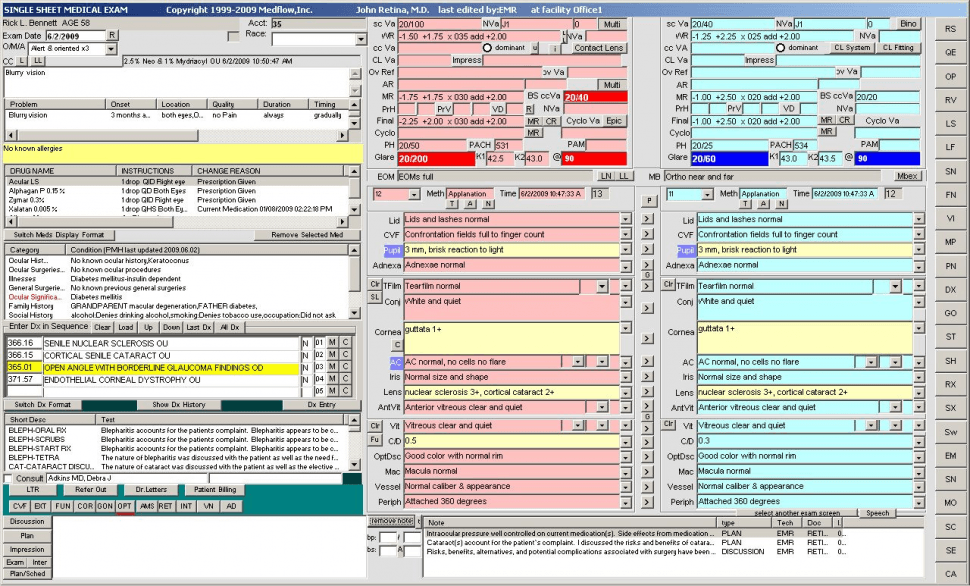Top 5 Best Ophthalmology EMR
The ophthalmology market is booming, with a projected growth of 7.91% annually reaching a staggering $76.10 billion by (2032 Straits Research). In this thriving landscape, selecting the right Electronic Medical Records (EMR) system is crucial for efficient practice management and delivering exceptional patient care. But with a variety of options, choosing the perfect fit can feel overwhelming.
This blog will guide you through the top 5 options in ophthalmology-specific EMR systems, empowering you to make an informed decision for your practice's future.
1. CureMD
CureMD distinguishes itself with a user-friendly interface specifically crafted for ophthalmologists. This focus on user experience translates into a system that feels intuitive and efficient for both doctors and staff.
Unlike generic EMR systems, CureMD boasts pre-built ophthalmic templates, integrated ophthalmic imaging tools, and functionalities tailored for managing common ophthalmic procedures and diagnoses. This targeted approach eliminates the need for time-consuming customization and ensures a smooth workflow from the start.
Key features include
- Faster documentation: Pre-built templates minimize data entry.
- Enhanced care delivery: Order management and reporting tools support informed decisions.
- Improved communication: Automated reminders and patient education materials boost engagement.
- Practice management boost: Seamless integration simplifies tasks like scheduling, billing, and inventory.
- Dedicated support: A dedicated team ensures a smooth transition and ongoing assistance.
Cons of CureMD
- Cost: Might not be the most budget-friendly option for all practices, especially smaller ones.
- Setup complexity: The initial setup process might be more complex compared to simpler EMR systems.
2. EMA Ophthalmology
EMA Ophthalmology stands out for its cloud-based architecture, eliminating the need for on-site hardware and simplifying system maintenance. This translates to greater accessibility and flexibility, allowing you to access patient data and manage your practice from any internet-connected device. Furthermore, EMA boasts a user-friendly interface specifically tailored for ophthalmologists, ensuring a smooth learning curve and efficient workflow integration.
Key features include
- Pre-built templates: Save time with pre-loaded ophthalmic templates for history, exams, and notes.
- Patient portal: Foster communication with a built-in portal for appointment scheduling, record access, and secure messaging.
- Telehealth: Expand your reach and offer convenient care options with built-in telehealth functionalities.
- Advanced order management: Simplify ordering medications, labs, and imaging directly within the system.
EMA also offers functionalities for
- Secure internal communication
- Data-driven decision making with reports and analytics
- Customizable dashboards for a personalized workflow
EMA Ophthalmology Drawing Board
Cons
- Limited Functionality
- Cloud Dependence
- Potential Security Concerns
- Hidden Costs
3. Medflow
Medflow stands out for its scalability. Whether you're a small, single-doctor practice or a larger ophthalmology group, Medflow can adapt to your size and specific needs. The system boasts a user-friendly interface, making it easy for doctors and staff to learn and navigate. Furthermore, Medflow prioritizes real-time data access, empowering you to make informed decisions with the most up-to-date information at your fingertips.

Key features include:
- E-prescribing: Saves time, reduces errors by sending prescriptions electronically.
- Patient education tools: Empowers patients with resources accessible through the patient portal.
- Inventory management: Tracks supplies in real-time, ensures you're always stocked up.
- Real-time reporting: Provides valuable insights into practice performance for informed decision-making.
Medflow also offers:
- Secure messaging
- Appointment scheduling & reminders
- Customizable dashboards
Cons of Medflow
Limited Functionality: May lack specialized features needed by some practices.
Scalability Cost: Scalability might come with a higher price tag compared to basic EMR systems.
Unclear Pricing: Base price might not be the full picture, consider potential additional costs for features or data storage.
4. EyeMD EMR
EyeMD EMR distinguishes itself with its focus on affordability. Compared to some feature-rich EMR systems, EyeMD offers a competitive price point, making it a viable option for practices looking for a cost-effective solution. Despite its affordability, EyeMD prioritizes user-friendliness with a clean and intuitive interface. This ensures a smooth learning curve for both doctors and staff, minimizing disruption to your daily operations.
Key features include:
- Pre-populated templates: Save time with pre-loaded ophthalmic forms.
- Integrated imaging: Capture and manage eye images directly in patient records.
- Automated reminders: Reduce no-shows with appointment reminders.
- Patient portal: Improve communication with a secure patient portal.

Cons of EyeMD EMR
Limited Functionality: May lack advanced features needed by some practices compared to higher-priced EMR systems.
Potential Feature Trade-off: Affordability might come at the cost of a smaller feature set.
Unclear Scalability: Information on how EyeMD EMR scales with practice growth might be limited.
5. Nextech Ophthalmology
Nextech Ophthalmology stands out for its comprehensiveness. It goes beyond basic EMR functionalities, offering a suite of integrated tools for practice management, revenue cycle management, business intelligence, and patient engagement. This all-in-one approach empowers large practices to streamline workflows, improve efficiency, and gain valuable insights into their operations. While Nextech offers a powerful set of features, it's important to note that the system might have a steeper learning curve compared to some basic EMR solutions.
Key features include:
Streamline workflows: Integrate practice management tools for scheduling, billing, inventory, and HR.
Maximize revenue: Streamline billing with automated claims and denial management.
Optimize operations: Gain valuable insights with business intelligence tools to make data-driven decisions.
Prioritize patients: Foster communication with patient portals, online scheduling, and reminders.
Cons of Nextech Ophthalmology
Scalability Concerns: While Nextech caters to large practices, how effectively it scales with practice growth might require further investigation.
Limited Customization: Nextech's all-in-one approach might limit customization options, potentially hindering practices with specific workflows or needs.
Choosing the Right Ophthalmology EMR
It can be seen that there is a wide range of Ophthalmology EMR in the market and choosing the one that matches your business requirements is not a simple decision . It requires careful consideration of your practice's unique needs and budget.
Don't be lured by the most feature-rich option; prioritize functionalities that directly address your workflow challenges and patient care goals. Consider factors like practice size, budget constraints, desired level of user-friendliness, and the importance of specific features like integrated imaging or telehealth capabilities.
If you want to build a custom Ophthalmology EMR that suits your business, don’t hesitate to contact Ominext to develop a robust system designed for you.
Conclusion
Selecting the right Electronic Medical Record (EMR) system is crucial for any ophthalmology practice aiming to enhance efficiency, ensure compliance, and improve patient care. The top five best ophthalmology EMR systems we explored - CureMD, EMA Ophthalmology, Medflow, EyeMD EMR, and Nextech Ophthalmology - each offer unique features tailored to meet the specific needs of ophthalmologists. Whether it's seamless integration with customizable templates, or robust patient management tools, these EMR systems provide solutions that can significantly streamline workflows.





